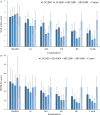Dose-related effects of radial extracorporeal shock wave therapy for knee osteoarthritis: A randomized controlled trial
- PMID: 33367924
- PMCID: PMC8772366
- DOI: 10.2340/16501977-2782
Dose-related effects of radial extracorporeal shock wave therapy for knee osteoarthritis: A randomized controlled trial
Abstract
Objective: To assess the dose-related effects of radial extracorporeal shock wave therapy on pain alleviation in knee osteoarthritis.
Methods: With the use of a 2?×?2 factorial randomized controlled design, 89 patients diagnosed with knee osteoarthritis were assigned to 1 of 4 treatment groups, which varied in terms of shock intensity (0.12 mJ/mm2, lower density, or 0.24 mJ/mm2, higher density) and shock number (2,000 impulses or 4,000 impulses), or to a placebo control. Each group received 4 sessions of radial extracorporeal shock wave therapy, one week apart. The primary outcome was pain intensity measured on a visual analogue scale, and the secondary outcome was the Western Ontario and McMaster Universities Osteoarthritis Index (WOMAC) score. Assessments were performed at baseline, after each session, and at 4-week follow-up.
Results: Two-way repeated-measures analysis of variance revealed a significant effect on the Pain score for intensity (p<0.001), with no effect for number (p=0.467) or the intensity?number interaction (p=0.536). Similar results were obtained for the WOMAC scores, except for an association between number and WOMAC score (p=0.036). At the 4-week follow-up, all treatment groups showed greater reductions in the Pain and WOMAC scores than the control group. In addition, scores decreased more at higher densities of shock intensity than at lower densities, while there was no significant difference between the 2,000- and 4,000-shock conditions.
Conclusion: Moderate-intensity radial extracorporeal shock wave therapy was effective, and a higher density might be more efficacious in alleviating pain in knee osteoarthritis.
Keywords: dose-response relationship; knee osteoarthritis; radial extracorporeal shock wave therapy.
Figures




Similar articles
-
Radial extracorporeal shock wave therapy for pain and function in adults with knee osteoarthritis: protocol for a placebo-controlled, randomized clinical trial.Trials. 2025 Apr 25;26(1):139. doi: 10.1186/s13063-025-08844-4. Trials. 2025. PMID: 40281559 Free PMC article.
-
A Randomized Controlled Trial on the Effects of Low-Dose Extracorporeal Shockwave Therapy in Patients With Knee Osteoarthritis.Arch Phys Med Rehabil. 2019 Sep;100(9):1695-1702. doi: 10.1016/j.apmr.2019.04.020. Epub 2019 Jun 10. Arch Phys Med Rehabil. 2019. PMID: 31194946 Clinical Trial.
-
Comparative Effectiveness of Focused Extracorporeal versus Radial Extracorporeal Shockwave Therapy for Knee Osteoarthritis-Randomized Controlled Study.Int J Environ Res Public Health. 2022 Jul 24;19(15):9001. doi: 10.3390/ijerph19159001. Int J Environ Res Public Health. 2022. PMID: 35897371 Free PMC article. Clinical Trial.
-
Extracorporeal shockwave therapy improves pain and function in subjects with knee osteoarthritis: A systematic review and meta-analysis of randomized clinical trials.Int J Surg. 2020 Oct;82:64-75. doi: 10.1016/j.ijsu.2020.07.055. Epub 2020 Aug 13. Int J Surg. 2020. PMID: 32798759
-
The efficacy and safety of extracorporeal shockwave therapy in knee osteoarthritis: A systematic review and meta-analysis.Int J Surg. 2020 Mar;75:24-34. doi: 10.1016/j.ijsu.2020.01.017. Epub 2020 Jan 21. Int J Surg. 2020. PMID: 31978648
Cited by
-
The efficacy of extracorporeal shock wave combined with platelet rich plasma in the treatment of knee osteoarthritis with meniscus injury: A retrospective analysis.Pak J Med Sci. 2024 Jan-Feb;40(3Part-II):382-387. doi: 10.12669/pjms.40.3.8670. Pak J Med Sci. 2024. PMID: 38356839 Free PMC article.
-
The Short-Term Efficacy of Large-Focused and Controlled-Unfocused (Radial) Extracorporeal Shock Wave Therapies in the Treatment of Hip Osteoarthritis.J Pers Med. 2022 Dec 26;13(1):48. doi: 10.3390/jpm13010048. J Pers Med. 2022. PMID: 36675709 Free PMC article.
-
Evaluation of treatment parameters for focused-extracorporeal shock wave therapy in knee osteoarthritis patients with bone marrow lesions: a pilot study.J Rehabil Med. 2024 Mar 12;56:jrm13207. doi: 10.2340/jrm.v56.13207. J Rehabil Med. 2024. PMID: 38470167 Free PMC article. Clinical Trial.
-
Radial extracorporeal shock wave therapy for pain and function in adults with knee osteoarthritis: protocol for a placebo-controlled, randomized clinical trial.Trials. 2025 Apr 25;26(1):139. doi: 10.1186/s13063-025-08844-4. Trials. 2025. PMID: 40281559 Free PMC article.
-
The efficacy of extracorporeal shock wave therapy for knee osteoarthritis : an umbrella review.Int J Surg. 2024 Apr 1;110(4):2389-2395. doi: 10.1097/JS9.0000000000001116. Int J Surg. 2024. PMID: 38668665 Free PMC article.
References
-
- Grazina R, Andrade R, Bastos R, Costa D, Pereira R, Marinhas J, et al. . Clinical management in early OA. Adv Exp Med Biol 2018; 1059: 111–135. - PubMed
-
- Bedson J, Jordan K, Croft P. The prevalence and history of knee osteoarthritis in general practice: a case-control study. Fam Pract 2015; 22: 103–108. - PubMed
-
- Kon E, Filardo G, Drobnic M, Madry H, Jelic M, Dijk N, et al. . Non-surgical management of early knee osteoarthritis. Knee Surg Sports Traumatol Arthrosc 2012; 20: 436–449. - PubMed
-
- Gerald Gremion, David Gaillard, Pierre-Francois Leyvraz, Brigitte M Jolles. Effect of biomagnetic therapy versus physiotherapy for treatment of knee osteoarthritis: a randomized controlled trial. J Rehabil Med 2009; 41: 1090–1095. - PubMed
Publication types
MeSH terms
LinkOut - more resources
Full Text Sources
Other Literature Sources
Medical

